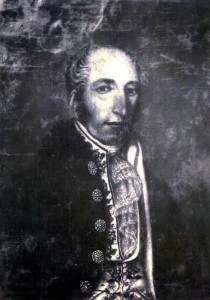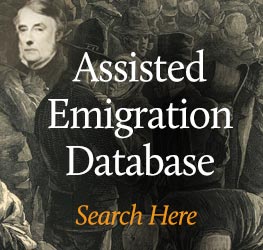 John D’Arcy (1785 – 1839)John D’Arcy founded Clifden in 1812. At the time, he was just twenty-six years of age, married and the father of three sons. He was also the proprietor of an estate that covered over 17,000 acres on the west coast of Connemara. The lands had been in the D’Arcy family for over 150 years, but they would be lost within a generation.
John D’Arcy (1785 – 1839)John D’Arcy founded Clifden in 1812. At the time, he was just twenty-six years of age, married and the father of three sons. He was also the proprietor of an estate that covered over 17,000 acres on the west coast of Connemara. The lands had been in the D’Arcy family for over 150 years, but they would be lost within a generation.
The D’Arcys were a Galway family, one of the fourteen powerful families known as The Tribes of Galway. The family seat was at Kiltullagh, near Athenry, but John was very much a Connemara man; his mother was a Lynch from Barna and his grandmother, also named Lynch, was from Drimcong in Moycullen.
Ever since inheriting the family estates in 1804, it was John’s ambition to establish a town on his Connemara lands. There were, however, many disadvantages to overcome and it would be years before the town would begin to take shape. Although slow to start, the town developed rapidly in the 1820s. The census figures for 1821 show the town as having 46 houses and a population of 290. By 1831, the population had jumped to 1,257 and there were 196 houses. Schools and churches dominated the skyline to the north of the town, while industrial buildings occupied the south; there was a brewery, distillery and mill on the banks of the Owenglin River River, next to the waterfall.
John D’Arcy died in 1839. At the time of his death, John’s ambition had been achieved. Clifden was then the headquarters for the coastguard and police force for the district. It had a bridewell and before long there would be a courthouse and workhouse. The town was thriving and the economic benefits to the region were becoming clear as more land in the neighbourhood was brought under cultivation and agricultural production increased to supply the growing market.
Throughout the years of the Great Famine, Clifden became the centre for administering relief in Connemara. The town witnessed many painful scenes during this time, as the streets filled with starving people desperately seeking work, food or charity, and when these were exhausted, access to the workhouse. Many houses in the town became tenements to house those who had abandoned their holdings so as to become eligible for relief, creating a breeding ground for cholera that reached epidemic proportion in 1849. When one takes in to account the inmates of the workhouse and the jail, Clifden was the only townland in the parish to show a sizable increase in population in the 1851 census.
The Famine affected all classes and ultimately caused the ruin of the D’Arcy family. Hyacinth D’Arcy, John’s son and heir, was forced to sell the town, along with the rest of the D’Arcy estates, in the 1850s. Thomas and Charles Eyre of Bath, England, eventually purchased the Clifden estate for £21,245. Representatives of the new landlords would live on at Clifden Castle until the close of the 19th century.
It took years to recover from the Great Famine and there was periodic crop failure and times of hardship in the years that followed. However, the opening of the Galway to Clifden railway line in 1895 did much to improve the economy of the town and helped to establish Connemara as a tourist destination. The opening of the Marconi Wireless station at Derrygimla in October 1907, and the arrival of the first transatlantic flight there on 15 June 1919, brought fame in the early years of the 20th century. The years immediately afterwards, however, saw war and destruction visited on the streets. On St Patrick’s Day 1921, during the War of Independence, the Black and Tans burned fourteen houses and shot two civilians, one of them fatally, in retaliation for the shooting dead of two policemen by members of the IRA some hours earlier. In the Civil War there was a ten-hour battle fought in the streets between the opposing sides.
Recent years have, thankfully, been more peaceful. Since the foundation of the Irish Republic, the town has focused on developing a sound economy for the local population, relying heavily on the thousands of tourists who continue to visit each year.
With its beautiful landscape, plentiful activities and fascinating history it is no wonder that visitors fall in love with the capital of Connemara. In the past 200 years, the people of Clifden have displayed a resilience equal to that of the town’s founder. Now in 2012 they can celebrate the rich and authentic heritage of their town with justified pride and confidence.
by Kathleen Villiers-Tuthill




I HAVE BEEN TRYING TO CONNECT MY D’ARCY FAMILY WITH JOHN D’ARCY OF CLIFDEN. I HAVE A DRAWING OF HORSEMEN OUTSIDE OF THE GATE HOUSE OF THE CASTLE AND MY GREAT AUNT TOLD US THAT HER GRANDAD PATRICK HELP TO BUILD IT AT THE TURN OF THE 1800s. HOW TRUE THIS IS I AM UNSURE. CAN YOU PUT ME IN TOUCH WITH ANYONE WHO MIGHT BE ABLE TO HELP IN MY RESEARCH PLEASE. HOPING TO HEAR FROM YOU WHEN AND IF YOU HAVE THE TIME. THANK YOU FROM BILL BROOK
I am also descended from the D’Arcy family of Galway. Check out this book:
The Register of the Kentucky Historical Society
I’m from America, so this book is how I found out. My Aunt is the one who knows about this D’Arcy family.
i so happen to look for history of connemara region where my wife was born from lettermore na-coille galway maiden name connolly we are trying to find out my wifes great uncle mike connolly came over on whatever ship during the 1890 .
Hussey is my family interest .Patrick was married to Mary maiden name ? His parents were Patrick Hussey and Annie Kennealy
Patrick and Mary’s children were Michael & Kitty-Peggy Religion RC.
Patrick was sent to Hobart Town in Tasmania as a convict for sheep stealing his trail was at Galway 21 June 1847 he arrived in Tasmania Australia on the 23 February 1849 he was 30 years old when tried.
Patrick is buried in Melbourne Victoria Australia with 3 of his 13 children to his children Margaret , after he served his 7 year
sentence in Hobart Town .Patrick was born about 1817 going on his convict records I have more info if this is of interest to you John
I did find a Mary Hussey who died at Clifden in 1866 who could have been Patricks wife, mother of Michael and Kitty-Peggy.
I am looking for my Mums birth Mother or family.
Margaret Flaherty gave birth in 1954.
Hello – do you have any names of Margaret’s family? Or exactly where they are from?
Finally I have found out why Hyacinth sold the 17,000 acres! Thank you so much for sharing this. John D’Arcy was my 5th great grand father. I can now share this information with my 87 year old grandmother. She doesn’t know any of her family tree history, so there is much of her father’s side that I have to share with her. I’m sure Nan will be very proud.
Regards,
Diane
Stone
Hello Diane,
I would be very interested in reading your findings as I have been researching my GM’s family (D’Arcy) back to Connemara and am trying to find out more about her father (John).
Many thanks in advance,
Paul
Pingback: The unparalleled beauty of Connemara National Park – Travelling Dany
I can trace my family back to James Greaney I think may have had 2 sons names I am not sure of. One son went to Liverpool and was a clerk I think at the docks he had 2 sons one was James the other John he was my great grandfather he came to Australia. the other died in Liverpool.
The other son I think his name may have been Martin had a son who later became a priest he was stationed in Headford?. The information I have and its not much is from a letter the priest wrote to my great grandfather. Any information would be great
Interested in Margaret D’Arcy born 1835 Limerick, said to have been born in Ballybunian Castle. She later married a Richard Poucher from Lincolnshire
Lots of stories, Margaret was apparently a daughter of the Marquess of Waterford
and Lord Charles Beresford was either her brother or uncle
Would be grateful for any further information
My grandfather, a D’Arcy,a descendant of John D’Arcy , was deported from Ireland to South Africa for sedition. He fought in the Boer War against the British in the 1880’s. I would love to trace his origins.
Hello I was wondering if you could help me find out the names of the owners of Clifden castle that own the castle today. Thank you in advance for your help God bless